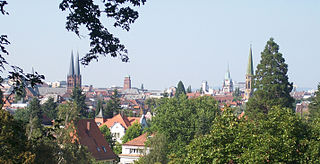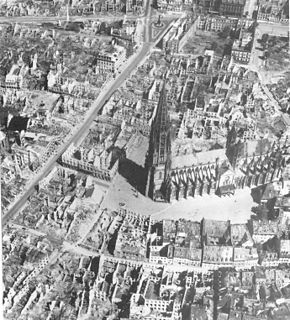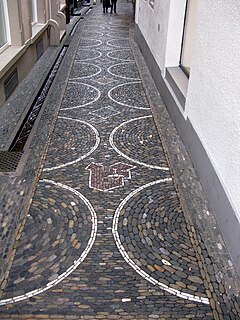
Freiburg im Breisgau, commonly referred to as Freiburg, is an independent city in Baden-Württemberg, Germany. With a population of about 230,000, Freiburg is the fourth largest city in Baden-Württemberg after Stuttgart, Karlsruhe, and Mannheim. The population of the Freiburg metropolitan area was 656,753 in 2018. In the south-west of the country, it straddles the Dreisam river, at the foot of the Schlossberg.

Wiehre is a residential district at the edge of Freiburg im Breisgau, located southwards and across the River Dreisam from the Old City. It is a desirable district, with comparatively quiet streets and many well-preserved commercial and residential buildings dating from the 18th century and earlier. Housing there is expensive relative to the rest of the city. The Wiehre is bordered on the west by the Rheintalbahn Karlsruhe-Basel, on the north by the Dreisam, on the east by the Waldsee, and on the south by a wood known as the Sternwald am Bromberg and the village of Günterstal. The Günterstal Landstrasse, which begins at the St. Martin's Gate in the ancient town wall, bisects the Wiehre.
Haslach, incorporated into the city on 1 January 1890, is one of the Western districts of Freiburg im Breisgau. After the demerging of Weingarten the district is made up out of the boroughs 611 Haslach-Egerten, 612 Haslach-Gartenstadt, 613 Haslach-Schildacker and 614 Haslach-Haid. Its population is 20,939 (2020).

Freiburg Hauptbahnhof is the main railway station in the German city of Freiburg im Breisgau. The Rhine Valley Railway (Mannheim–Basel), Höllentalbahn and the Breisach Railway (Breisach–Freiburg) meet here.
The Martinstor, a former town fortification on Kaiser-Joseph-Straße, is the older of the two gates of Freiburg im Breisgau that have been preserved since medieval times. Both gates, the Martinstor and the Schwabentor, are located in the city centre. In medieval times the Martinstor was also known as Norsinger Tor.

Operation Tigerfish was the military code name in World War II for the air raid on Freiburg in the evening of 27 November 1944 by the Royal Air Force with about 2,800 dead.

The Freiburg im Breisgau tramway network (also known as Stadtbahn or formerly as Hoobl is a network of tramways forming part of the public transport system in Freiburg im Breisgau, a city in the federal state of Baden-Württemberg, Germany. Opened in 1901, the network has been operated since its foundation by the company now known as Freiburger Verkehrs and powered by electricity. Currently, the tramway network has five lines. The expansion of the tram network since 1980 has served as an example of the "renaissance of the trams" in Germany. At the start of 2017, 72 trams were available for regular use. Five of these were high-floored, 37 partial and 30 low-floored. Almost the entirety of the network is located within Freiburg's urban area, only a few metres of the balloon loop at Gundelfinger Straße are located outside the boundary of Gundelfingen to the north of Freiburg. In total, the trams serve 20 out of the 28 districts in Freiburg.

The Kaiser-Joseph-Straße in Freiburg im Breisgau is a shopping street of about 900 meters, which runs through the center of Freiburg's historic downtown from north to south. It is one of the most expensive locations in Germany.

The Bertoldsbrunnen is a monument in the historic city of Freiburg im Breisgau. It is situated at the crossing of the Salz- and Bertoldsstraße with the Kaiser-Joseph-Straße. The fountain is one of the central locations of the city. A tram station with the same name is situated at the Bertoldsbrunnen where four of the five tramways of the Freiburger Verkehrs AG stop.

The Minster Square in the centre district of Freiburg is a paved area surrounding the Freiburger Minster. The city library, the Historical Merchants' Hall, the Wentzinger House and also the Korn House are located on this square. The Freiburger streams run along the sides of the square.

Stühlinger is a district to the west of the historic city center of Freiburg im Breisgau. In December 2013, 18,300 residents lived in the neighborhood. There are three boroughs: Stühlinger-Beurbarung, Stühlinger-Eschholz and Alt-Stühlinger. Although historically correct, the railroad Freiburg-Colmar is the north end of the Stühlinger and therefore Stühlinger-Beurbarung is not part of the district anymore. The district borders the area of the central train station of the Deutsche Bahn AG to the east, the river Dreisam to the south, tracks of the railroad freight transportation to the west and the district Brühl to the north.

Freiburg im Breisgau's parks, green spaces, recreational facilities, playgrounds, roadside greeneries and the Mundenhof add up to an area of 397 ha (3.97 km2), which corresponds to 18.05 m2 of green space per Freiburg citizen. On average, major cities in Baden-Württemberg have 22.66 m2 green space/citizen. However, there is an area of 2600 ha (26 km2) of forest in the close proximity of Freiburg as well as additional recreational area like the Rieselfeld district. The majority of the green spaces came into existence from the 1960s on.
The Salzstraße in Freiburg im Breisgau is a significant part of the Freiburg city centre pedestrian area. It runs from Bertoldsbrunnen to Kaiser-Joseph-Straße, then eastward to Oberlinden square, where a fountain of the same name is located. It is probably the location of Freiburg's oldest houses. A stream, the Freiburg Bächle, runs along the street's northern side between the tramway tracks and the pavement.
Mooswald is a district in the western part of Freiburg im Breisgau, which consists of the two districts Mooswald West (521) and Mooswald East (522). Its population is 9,223 (2020). In the North East, Mooswald borders the district of Brühl, with its airfield, the University campus of the technical faculty and the exhibition centre. Mooswald further borders the district of Landwasser in the North West, the district of Stühlinger in the East and the district of Betzenhausen with the Seepark in the South West. Mooswald is separated from Brühl by the Breisgau S-Bahn, from Landwasser by the Westrandstraße (Paduaallee/Mooswaldallee) and from Stühlinger by the railway tracks of the freight railway.

The Johanneskirche is a catholic church located in Freiburg im Breisgau. It was first opened in 1899 and is currently located in the Wiehre district. Around the church, further historic buildings were built. On the western side is the presbytery of the community next to a vocational school and to the north is the Lessingschule. At the same time as the Johanneskirche was being completed, the Protestant Christians built their own church near to Johanneskirche, the Christuskirche.

The Platz der Alten Synagogue is a square in Freiburg, Germany. With a size of 130 square metres, it is the second largest square in the city after Minster Square. The square is named after the old synagogue, which was destroyed during the Kristallnacht in 1938. The synagogue had been built in 1869/1870 to the southwest of today's location of the square.

Cobblestone mosaics can be found throughout Freiburg im Breisgau. Most mosaics are embedded in the cobblestone pavement of the city centre of Freiburg.

Neuburg is a quarter of the German city Freiburg im Breisgau. The district is located directly north of the old town with its numerous sights and includes the Schlossberg which is situated east of the city's historic center. Neuburg adjoins the district Oberau on wooded Schlossberg, as well as it adjoins Herdern in the north. On its western side, the district is cut off from Stühlinger by the tracks of the Rheintalbahn running from Mannheim to Basel.

Wiwilíbrücke is a bridge of the German city Freiburg im Breisgau which is also called Blaue Brücke because of its paint and it had formerly been called Stühlingerbücke before the new Stühlingerbücke was built for the tramway. The bridge connects the city’s district Stühlinger to the old town as it links the church square of Herz-Jesu-Kirche to Konrad-Adenauer-Platz in spanning the railway tracks of Freiburg Hauptbahnhof. Today, Wiwilíbrücke is a listed building and is used by up to 10,000 cyclists per day.

The Stühlinger bridge was made of prestressed concrete for tramways, pedestrians and cyclists in Freiburg im Breisgau. It connects the Bertoldstraße with the Wannerstraße. In doing so, it crosses the Bismarckallee, the central bus station, the main railway station Hauptbahnhof, the Wetzingerstraße and the Stühlinger Church Square. The right short individual sections make it seem like an inner-city viaduct or an elevated highway in proportion to the whole length.


















